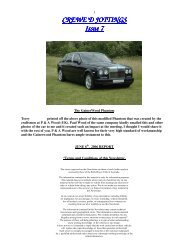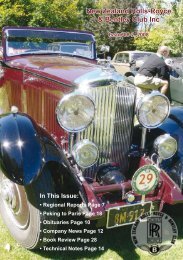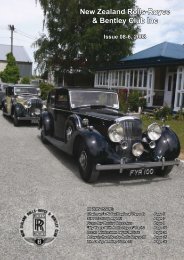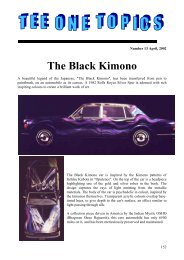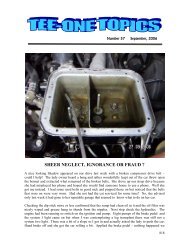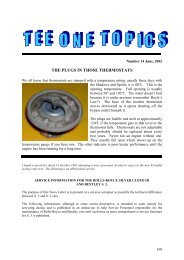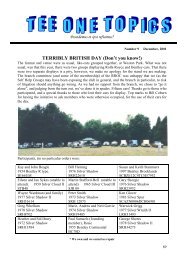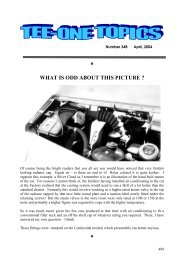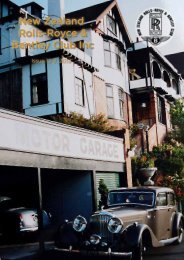Re-building an HP20 Engine - Part 2 - The Enthusiasts Website for ...
Re-building an HP20 Engine - Part 2 - The Enthusiasts Website for ...
Re-building an HP20 Engine - Part 2 - The Enthusiasts Website for ...
Create successful ePaper yourself
Turn your PDF publications into a flip-book with our unique Google optimized e-Paper software.
Fig. 5. Cam followers upon removal. Test them <strong>for</strong> wear after a<br />
thorough cle<strong>an</strong>ing.<br />
Fig. 6. F<strong>an</strong> pulley prior to removal <strong>an</strong>d extraction of timing case<br />
cover.<br />
1756<br />
<strong>Re</strong><strong>building</strong> <strong>The</strong> 20 HP <strong>Engine</strong><br />
<strong>Re</strong>moval Of <strong>The</strong> Sump<br />
Prior to the lowering of the sump the timing case<br />
cover must be loosened <strong>an</strong>d the starter assembly<br />
removed (see Figures 6-8). <strong>The</strong> first step in loosening of<br />
the timing case cover is the removal of the "dynamo<br />
brake blocks". <strong>The</strong>se are located under small plates<br />
(top <strong>an</strong>d bottom) on the timing case cover immediately<br />
in front of the dynamo. Loosen <strong>an</strong>d remove the four<br />
4BA nuts <strong>an</strong>d lock washers <strong>an</strong>d extract the spring <strong>an</strong>d<br />
pry out the two brake shoes. Save <strong>for</strong> measurement <strong>an</strong>d<br />
replacement. <strong>The</strong>se are, in effect, vibration dampers<br />
<strong>for</strong> the front end of the dynamo drive, since switching<br />
in the charging circuit causes considerable increase in<br />
the torsional vibration. Clear all oil lines not previously<br />
removed <strong>an</strong>d loosen all nuts <strong>an</strong>d screws. <strong>The</strong> timing<br />
case cover itself c<strong>an</strong> be removed later after the f<strong>an</strong><br />
pulley has been removed.<br />
To remove the starter motor <strong>an</strong>d drive unit, first<br />
detach the cable. <strong>Re</strong>move the starter drive from the<br />
rear by undoing the four long studs. Gently pry off the<br />
cover cap which also houses the rear bearing of the<br />
starter drive. Pull the drive out the rear. <strong>The</strong> starter<br />
<strong>Part</strong> II<br />
By Lee P. Haacker, M.D.<br />
motor should then lift out the front without difficulty.<br />
Start attacking the various p<strong>an</strong> bolts, noting that they<br />
have m<strong>an</strong>y lengths <strong>an</strong>d configurations with a bit filed<br />
off here <strong>an</strong>d there to fit tight spots. Mark <strong>an</strong>d catalog<br />
them in some way (to reduce the time waste of trial<strong>an</strong>d-error<br />
fitting on reassembly. Leave the oil pump<br />
attached which will be removed <strong>an</strong>d disassembled <strong>for</strong><br />
cle<strong>an</strong>ing later. Place a creeper under the p<strong>an</strong> <strong>an</strong>d try<br />
to separate it from the upper half. It will yield with all<br />
of the kicking <strong>an</strong>d screaming expected. Do not jam<br />
wedges, screwdrivers, etc. between the mating aluminum<br />
surfaces to pry loose the p<strong>an</strong>. This may score the<br />
soft metal joint, allowing leaks to develop. <strong>The</strong> amount<br />
of sludge in the bottom of the sump will be appalling.<br />
<strong>The</strong> big ends <strong>an</strong>d mains in this engine were heavily<br />
crudded with sludge, which tended to cover up such<br />
goodies as cotter pins, tabbed locking washers, etc.<br />
Note that the rear main oil seal is composed of oil<br />
slinger rings <strong>an</strong>d multiple holes in the cr<strong>an</strong>kcase <strong>an</strong>d<br />
spiral grooves cut in the adjacent, closely fitted<br />
cr<strong>an</strong>kshaft. <strong>The</strong>se were later replaced by felt seals.<br />
More on this later.<br />
Fig. 7. <strong>The</strong> five retaining nuts have been removed <strong>an</strong>d the locking<br />
plate is shown being extracted.<br />
Fig. 8. F<strong>an</strong> pulley has been removed <strong>an</strong>d the left-h<strong>an</strong>ded nut which<br />
locks the starting dog in place is being loosened.
Fig. 9. Underside of front half of engine. Shown are second <strong>an</strong>d<br />
third main bearing caps removed, first still in place. Note the<br />
general filth. One of the slots <strong>for</strong> the Woodruff key is seen in the<br />
cr<strong>an</strong>k nose.<br />
Rods <strong>an</strong>d Pistons<br />
Each of the connecting rods is marked on the near<br />
side at its base <strong>an</strong>d on the bearing cap, marked<br />
identically on the adjacent surface. In addition, they<br />
are marked <strong>for</strong> orientation, one through six. <strong>The</strong><br />
pistons are mounted on the connecting rod with<br />
the split skirt on the cam side (i.e. the thrust or<br />
"pressure" side during the firing stroke is solid <strong>an</strong>d is<br />
opposite the cam).<br />
<strong>Re</strong>move the cotter pins <strong>an</strong>d unbolt the nuts using a<br />
torque wrench. <strong>Re</strong>cord the torque figures to get some<br />
idea of the variation that "<strong>an</strong> old fitter" c<strong>an</strong> produce<br />
while using a six-inch tommy bar. Carefully remove the<br />
bearing cap <strong>an</strong>d look <strong>for</strong> the shims (spacer) or "liner"<br />
that tends to cling to the rod <strong>for</strong> a few seconds, then<br />
falling to the floor. Keep the sequence of these<br />
accurately, particularly if remetalling of the bearings<br />
will not be necessary. Turn the cr<strong>an</strong>k to bring the<br />
piston to top then push it out using a wooden drift. It<br />
c<strong>an</strong> be easily lifted out from the top. <strong>Re</strong>peat <strong>for</strong> the<br />
remaining five, reattaching the liners (taking care not<br />
to invert <strong>an</strong>y) <strong>an</strong>d bearing caps temporarily. Carefully<br />
examine each bearing <strong>an</strong>d its shell <strong>for</strong> signs of<br />
loosening of the white metal <strong>an</strong>d fretting, i.e. oil<br />
between the bearing cap <strong>an</strong>d shell.<br />
<strong>The</strong> piston, gudgeon pin <strong>an</strong>d small end are of the<br />
"free floating" variety in that under operating tempera-<br />
Fig. 11. Number four <strong>an</strong>d number two main bearing caps. Note<br />
particularly the pitting <strong>an</strong>d striations on the bearing surfaces,<br />
which are indicative of considerable wear <strong>an</strong>d the need of<br />
replacement.<br />
Fig. 10. <strong>Re</strong>ar half of engine. Note the bl<strong>an</strong>king caps sealing the oil<br />
passages in the cr<strong>an</strong>k shaft.<br />
tures, the pin c<strong>an</strong> move to some degree in the small<br />
end. <strong>The</strong> piston is allowed similar float so that<br />
effectively neither the pin or piston is solidly fixed. <strong>The</strong><br />
pin is bored at either end to allow a small aluminum<br />
button to be pressed into it. This metal button will<br />
allow contact with the cylinder wall without allowing<br />
<strong>an</strong>y signific<strong>an</strong>t wear as would steel. On reassembly the<br />
piston will have to be heated slightly until it is too hot<br />
to h<strong>an</strong>dle without protective gloves, as will the small<br />
end, after which the gudgeon pin c<strong>an</strong> be slipped<br />
through without difficulty. <strong>The</strong> heating may be done in<br />
boiling water, <strong>an</strong> oven or carefully with a torch. Note<br />
that early engines used internal "snap rings" in the<br />
connecting rod-piston assembly.<br />
Next, <strong>The</strong> Block<br />
Prior to removing the block it is necessary to remove<br />
all of the cam followers <strong>an</strong>d their springs. <strong>The</strong>se live<br />
behind the two tappet covers on the near side. <strong>The</strong>y<br />
are best attacked sober <strong>an</strong>d early in the morning since<br />
they are tedious to approach <strong>an</strong>d do not seem to w<strong>an</strong>t<br />
to be disturbed. Unbolt the bridge which holds the two<br />
adjacent cam followers in place. <strong>Re</strong>move the bridge,<br />
spring caps <strong>an</strong>d springs, lifting the cam followers<br />
straight out. <strong>The</strong> spring caps may need a bit of prying<br />
<strong>an</strong>d the cam followers are usually quite slippery <strong>an</strong>d<br />
heavily sludged (see Figure 5). After a thorough<br />
cle<strong>an</strong>ing, the cam followers will have to be examined<br />
<strong>for</strong> wear, gudgeon pin play <strong>an</strong>d pin looseness.<br />
If the pins are loose, the roller surfaces pitted, or<br />
Fig. 12. Close-up of number four main bearing itself. Presence of<br />
wear <strong>an</strong>d the need <strong>for</strong> grinding is indicated by the m<strong>an</strong>y fine<br />
parallel lines in the cr<strong>an</strong>k surface.<br />
1757
1758<br />
Fig. 13. Oil sludged inside of the flywheel. A good indication that<br />
oil was passing through the rear oil seal <strong>an</strong>d into the clutch housing<br />
(not good <strong>for</strong> clutch longevity or the starter either).<br />
<strong>an</strong>y "toggle"-like play exists in the rollers, renewal<br />
is necessary.<br />
Attempt to lift the block over the studs. <strong>The</strong>se studs<br />
differ from the later engines in that they c<strong>an</strong>not be<br />
removed with the "two nut technique". <strong>The</strong>y are<br />
shouldered, threaded into the upper half cr<strong>an</strong>k case<br />
(completely through it) <strong>an</strong>d then into the cr<strong>an</strong>k<br />
chamber where they are held tightly with large<br />
castellated nuts <strong>an</strong>d locked with cotter pins. In<br />
addition to all of this nonsense, they are in practically<br />
inaccessible places. Leave their removal until the upper<br />
half cr<strong>an</strong>kcase c<strong>an</strong> be removed, gunked <strong>an</strong>d turned<br />
over; this will at least reduce the likelihood of madness.<br />
Once the cotter pin <strong>an</strong>d nut are removed, the stud c<strong>an</strong><br />
be backed out using the two-nut technique. If the<br />
rearmost center stud will not allow the block to clear, it<br />
c<strong>an</strong> be removed. <strong>The</strong> locking nut is fairly convenient<br />
from below <strong>an</strong>d this stud c<strong>an</strong> be removed quite easily.<br />
A Word About <strong>Engine</strong> <strong>Re</strong>moval<br />
If instead of removing the complete engine major<br />
disassembly was carried out in the chassis, then now is<br />
the time to remove the remaining upper half cr<strong>an</strong>kcase<br />
with its cr<strong>an</strong>kshaft, flywheel <strong>an</strong>d clutch attached. Using<br />
a suitable commercial engine cr<strong>an</strong>e or <strong>an</strong> overhead<br />
chainfall, pass a padded chain, or something like a<br />
used but intact f<strong>an</strong>belt, through cylinder locations 4<br />
<strong>an</strong>d 5 or 5 <strong>an</strong>d 6 <strong>an</strong>d attach the lifting hook. Place a<br />
Fig. 15. Upper half cr<strong>an</strong>kcase with main bearings shown (cr<strong>an</strong>kshaft<br />
removed). In <strong>for</strong>eground are two of the long studs that secure<br />
the main bearings. A single bearing "liner" is to the left below the<br />
number one main bearing cap.<br />
Fig. 14. From left to right: flywheel, metal friction plate, rear<br />
lining carrier plate <strong>an</strong>d rear clutch cover.<br />
small hydraulic jack under the <strong>for</strong>ward end of the<br />
tr<strong>an</strong>smission <strong>an</strong>d rig a chain or cable to support the<br />
tr<strong>an</strong>smission after the engine has gone. Unbolt the four<br />
<strong>for</strong>ward fixation points on the "wishbone". Unbolt the<br />
two large castellated nuts <strong>an</strong>d remove the bolts that<br />
comprise the rear engine supports <strong>an</strong>d extract the<br />
several studs joining the cr<strong>an</strong>kcase to the bell housing.<br />
On the off side there is one stud which likes to foul<br />
the clutch pedal just short of clearing <strong>an</strong>d may require<br />
a bit of patience. With all fingers crossed <strong>an</strong>d a little<br />
lift under the <strong>for</strong>ward end of the tr<strong>an</strong>smission with the<br />
jack, the engine should come up <strong>an</strong>d out without too<br />
much trauma. Watch the clear<strong>an</strong>ce of the two rear<br />
mounting arms. <strong>Re</strong>move the thrust bearing from the<br />
bell housing <strong>for</strong> later renewal.<br />
Dissection Of <strong>The</strong> <strong>Re</strong>mains:<br />
(A) <strong>The</strong> Slipper Flywheel<br />
With the engine placed on a stable support, right<br />
side up, go about the removal of the slipper as follows:<br />
(1) Unscrew the five securing nuts holding the<br />
locking plate to the f<strong>an</strong> pulley.<br />
(2) <strong>Re</strong>move the locking plate revealing the large<br />
left-h<strong>an</strong>ded serrated nut <strong>an</strong>d the "starting-dog" nut<br />
(the latter being the point of engagement <strong>for</strong> the<br />
later engines where six possible locations exist.)<br />
(3) Undo the serrated nut with the proper C-sp<strong>an</strong>ner<br />
(don't <strong>for</strong>get, left-h<strong>an</strong>ded). <strong>The</strong> "starting-dog" nut c<strong>an</strong><br />
Fig. 16. Detail <strong>for</strong> removal of hollow pins that locate <strong>an</strong>d fix the<br />
camshaft split bearings. A suitable sized screw has been inserted <strong>an</strong>d<br />
the hollow pin is in the process of being extracted.
1759<br />
be removed with a wrench.<br />
(4) Pull off the pulley.<br />
(5) Loosen or remove the dynamo brake blocks<br />
(two), top <strong>an</strong>d bottom. Disconnect oil line to timing<br />
gears.<br />
(6) Timing case cover removal should present no<br />
great problems other th<strong>an</strong> resist<strong>an</strong>ce to being moved.<br />
Be<strong>for</strong>e removing the slipper itself be sure to bring<br />
the number one cr<strong>an</strong>k to top dead center by observing<br />
the flywheel markings. (<strong>The</strong> slipper <strong>an</strong>d pinion will fit<br />
the cr<strong>an</strong>kshaft in only one of two positions so that<br />
failing to bring the cr<strong>an</strong>k to top dead center be<strong>for</strong>e<br />
removing the slipper will not be as bad <strong>an</strong> error as on<br />
later engines where six possible locations exists).<br />
Having done things properly, <strong>an</strong>d with a bottle of<br />
nail polish to mark the mating teeth, slipper extraction<br />
is next. This slipper, unlike the later variety, does not<br />
need a special extractor <strong>an</strong>d c<strong>an</strong> be drawn off by<br />
replacing the starting dog, fixing it with the proper<br />
nuts <strong>an</strong>d turning it off using a wrench only. As the<br />
slipper is slowly extracted, watch it carefully until it<br />
clears the Woodruff keys inside <strong>an</strong>d remove it the rest<br />
of the way marking the adjacent mating teeth, two on<br />
one component, <strong>an</strong>d the meshing tooth on the other,<br />
using the nail polish. As soon as practical, replace the<br />
nail polish markings with perm<strong>an</strong>ent marks made with<br />
a punch, drill or other metal-etching device. Be careful<br />
to remove the two Woodruff keys from the cr<strong>an</strong>k nose<br />
<strong>an</strong>d store them safely since they are not of st<strong>an</strong>dard<br />
U.S. size <strong>an</strong>d replacement is unlikely even if the<br />
hardware store m<strong>an</strong> knows what a Woodruff key<br />
is. Disassemble the remains of the slipper as is<br />
well-detailed in the Service Sheets RR/E-5. More on<br />
this later.<br />
Dissection Of <strong>The</strong> <strong>Re</strong>mains:<br />
(B) <strong>The</strong> Mains <strong>Re</strong>main<br />
Turning the upper half cr<strong>an</strong>kcase over, the mains c<strong>an</strong><br />
be approached. Be<strong>for</strong>e doing this, it might be a good idea<br />
to remove the clutch components to lessen the weight (see<br />
Figures 13 <strong>an</strong>d 14). This is well-detailed in RR/F-2, page<br />
13, of the Service Sheets. <strong>The</strong> large spring tension nuts<br />
(7/8W) were unbelievably tight but, using a long tommy<br />
bar (4 ft.) <strong>an</strong>d a sudden maximal ef<strong>for</strong>t, all brake loose<br />
fairly uni<strong>for</strong>mly. With the spring tension removed, the<br />
peripheral nuts c<strong>an</strong> come off easily. A locating stud on<br />
the periphery will prevent improper replacement of the<br />
cover. Lift out the clutch pressure ring (rear lining<br />
carrier), marking it if necessary. Lift out the driven plate<br />
which, in this car, showed discoloration from heat <strong>an</strong>d<br />
had small cracks throughout, not to mention considerable<br />
wear. Note that some of the later driven plates are<br />
spring loaded.<br />
<strong>The</strong> front friction plate is bolted to the rear surface<br />
of the flywheel. <strong>Re</strong>move the eight nuts <strong>an</strong>d the plate<br />
should come off easily. <strong>The</strong> rear friction plate is<br />
carried on the splined clutch pressure ring. <strong>Re</strong>line both<br />
elements. <strong>The</strong> whole assembly will require bal<strong>an</strong>cing<br />
with the rest of the moving parts. All is well-outlined in<br />
the Service Sheets, section F-2.<br />
This engine has three oil delivery tubes from the<br />
main gallery to main bearing caps of one, four <strong>an</strong>d<br />
seven. Mark each tube, noting that the first tube is not<br />
straight but slightly curved when seen from below. All<br />
tubes are locked with locking tabs which must be<br />
turned back be<strong>for</strong>e the tubes c<strong>an</strong> be removed.<br />
<strong>The</strong> mains are tied down by long studs which pass<br />
completely through the casting <strong>an</strong>d are secured with<br />
large castellated nuts <strong>an</strong>d pins (see Figures 9-15).<br />
<strong>Re</strong>move the pins <strong>an</strong>d use a torque wrench to back off<br />
the nuts <strong>an</strong>d record the observations. Use the same care<br />
<strong>an</strong>d org<strong>an</strong>ization when removing the bearing caps <strong>an</strong>d<br />
liners as with the big ends. Look <strong>for</strong> the markings,<br />
again on the cam side, <strong>an</strong>d do not switch or invert <strong>an</strong>y<br />
of the liners accidentally. All of this is essential if<br />
the cr<strong>an</strong>k surfaces are good, the clear<strong>an</strong>ces within<br />
acceptable limits <strong>an</strong>d renewal of the mains is not<br />
contemplated. If there is <strong>an</strong>y doubt, pl<strong>an</strong> to do the<br />
whole works.<br />
Dissection Of <strong>The</strong> <strong>Re</strong>mains:<br />
(C) Last, <strong>The</strong> Flywheel<br />
With little difficulty, but a lot muscle, the cr<strong>an</strong>k <strong>an</strong>d<br />
flywheel should lift out. Mark the base of the<br />
cr<strong>an</strong>kshaft flywheel fl<strong>an</strong>ge <strong>an</strong>d the flywheel to maintain<br />
their relationship. Do the same with the pilot bearing<br />
plate <strong>an</strong>d the flywheel inside. Back off the peened<br />
flywheel nuts <strong>an</strong>d try to separate the flywheel. It may<br />
be necessary to punch out the bolts from the rear or to<br />
use a little heat around each.<br />
rear or to use a little heat around each.<br />
Now with the cr<strong>an</strong>kcase lighter the studs c<strong>an</strong> be<br />
attacked, preferably after the carcass has been gunked<br />
or steam-cle<strong>an</strong>ed. <strong>The</strong> peripheral nuts holding the<br />
Fig. 17. Upper half cr<strong>an</strong>kcase after a good cle<strong>an</strong>ing, st<strong>an</strong>ding on its<br />
rear end. To the left is the oil gallery <strong>an</strong>d to the right are the<br />
ch<strong>an</strong>nels through which the cam followers are inserted. <strong>The</strong> camshaft<br />
has been removed.
1760<br />
Fig. 18. Line boring of the main bearings. Note that the cr<strong>an</strong>kcase<br />
has been "stabilized" by refitting the studs, block, <strong>an</strong>d lead pipe<br />
spacers <strong>an</strong>d tightening the nuts to torque as if the head were in<br />
place. <strong>The</strong> main bearings are, of course, at torque.<br />
studs are not too difficult to work on but the center<br />
row is <strong>an</strong> absolute bitch (see Figure 17).<br />
Conditions At <strong>The</strong> Front<br />
<strong>The</strong>re are several bearings in the front end of the<br />
cr<strong>an</strong>kcase which will probably need replacement, two<br />
in the dynamo drive, one on the <strong>for</strong>ward end of the<br />
camshaft, two in the idler <strong>an</strong>d one in the distributor<br />
drive. Fortunately replacement bearings are available<br />
in the U.S. <strong>an</strong>d their numbers are listed below. <strong>The</strong><br />
original Rolls-Royce numbers follow.<br />
Dynamo Drive, front - SAE 205 (Hoffm<strong>an</strong> 125)<br />
Dynamo Drive, rear - SAE 304 (Hoffm<strong>an</strong> 320)<br />
Camshaft - SAE 306 (Hoffm<strong>an</strong> 330)<br />
Idler Shaft, front - SAE 330 K (Hoffm<strong>an</strong> 317)<br />
Idler Shaft, rear - SAE 203 K (Hoffm<strong>an</strong> 117)<br />
Distributor - FAG MS9 (Hoffm<strong>an</strong> MS9)<br />
<strong>The</strong> disassembly of each will be described. Prior to<br />
disassembly all meshing teeth across the board should<br />
be marked perm<strong>an</strong>ently so that the same teeth c<strong>an</strong> be<br />
remated on reassembly.<br />
Dynamo Drive<br />
<strong>The</strong> disassembly of the dynamo drive is not difficult;<br />
however, take care <strong>for</strong> the Woodruff key <strong>an</strong>d the<br />
m<strong>an</strong>ner in which the rear bearing <strong>an</strong>d housing are<br />
assembled since inversion of this assembly is easy (see<br />
Figures 27, 28 <strong>an</strong>d 29). In this engine the front bearing<br />
Fig. 19. Upper half cr<strong>an</strong>kcase after fitting <strong>an</strong>d line boring of the<br />
main bearings. Note the small wires passed through the main oil<br />
delivery tubes to prevent them from contacting the cutter during<br />
boring <strong>an</strong>d from scarring the cr<strong>an</strong>ks' surface later.<br />
was absent <strong>an</strong>d its replacement had to be identified<br />
by measurement of the shaft <strong>an</strong>d the timing case<br />
cover recess.<br />
<strong>The</strong> detailed instructions <strong>for</strong> disassembly follow. <strong>The</strong><br />
entire unit is <strong>an</strong> interesting concept of holding the<br />
main gear drive stable <strong>an</strong>d allowing some flexibility<br />
<strong>an</strong>d shock absorption at the dynamo drive coupling.<br />
(1) Lock the idler wheel or cam wheel to keep the<br />
gears from turning freely.<br />
(2) <strong>Re</strong>move the cotter pin <strong>an</strong>d undo the 3/8 BS<br />
castellated nut on the <strong>for</strong>ward end.<br />
(3) With a wooden drift, tap the front end of the<br />
dynamo driveshaft. This will displace the driveshaft to<br />
the rear <strong>an</strong>d loosen the driving gear from its tapered<br />
shaft. <strong>Re</strong>move the gear <strong>an</strong>d extract the Woodruff key.<br />
Now the driveshaft spring c<strong>an</strong> be removed from<br />
the rear where the dynamo itself threads on via<br />
serrated nut.<br />
(4) Doing the above will reveal a large nut with<br />
locking tab. Bend back the tab <strong>an</strong>d undo the nut.<br />
<strong>Re</strong>move the small oil-throwing ring. Now the entire<br />
assembly consisting of the driveshaft, driving gear,<br />
front bearing <strong>an</strong>d the dynamic brake wheel c<strong>an</strong> be<br />
tapped out <strong>for</strong>ward, leaving the rear bearing in its<br />
housing. Study the relationships of the bearing housing<br />
prior to taking it down since it is quite easy to invert in<br />
reassembly. <strong>The</strong> housing is held in the cr<strong>an</strong>kcase by<br />
three short <strong>an</strong>d one slightly longer stud passing from<br />
front to rear (outside). A small locking ring is present<br />
on each to prevent the stud from falling back into the<br />
timing case if the nut should fall off. Note that<br />
the longer stud is located in the upper outer position<br />
to allow <strong>for</strong> the thickness of one of the vibration<br />
damper supports.<br />
(5) <strong>The</strong> drive gear <strong>an</strong>d shaft c<strong>an</strong> be taken down<br />
further. <strong>The</strong> drive gear itself is mounted on a tapered<br />
shaft <strong>an</strong>d <strong>for</strong> this reason c<strong>an</strong> fit on only one way. Using<br />
a gear extractor, pull the gear off from the rear. Again<br />
watch <strong>for</strong> the Woodruff key.<br />
(6) <strong>Re</strong>move the <strong>for</strong>ward bearing by using a gear<br />
extractor. A bit of heat on the old bearing may<br />
be of help.<br />
(7) <strong>The</strong> remaining shaft with the dynamic brake<br />
must then be examined <strong>for</strong> grooving <strong>an</strong>d wear on the<br />
surface of the wheel. <strong>The</strong> wheel on this unit was<br />
in fairly good shape <strong>an</strong>d did not need turning<br />
or replacement.<br />
(8) Prepare to renew the dynamo brake blocks that<br />
live in the timing case cover. <strong>The</strong> original 20 HP blocks<br />
(shoes) <strong>an</strong>d springs are apparently no longer available<br />
since they furnished longer blocks <strong>an</strong>d springs (from a<br />
later model engine). <strong>The</strong>se blocks have to be fitted by<br />
sawing off about 1/4 inch from the flat outer end. <strong>The</strong><br />
springs will also probably need shortening 1/8 inch or<br />
so. If one simply inserts the new shoes <strong>an</strong>d springs <strong>an</strong>d<br />
tightens up the covers the engine will not turn over.<br />
{To Be Continued)<br />
[Editor's Note: <strong>Re</strong>gretfully in <strong>an</strong> article of the length <strong>an</strong>d<br />
scope of the above, the text <strong>an</strong>d the pictures do not fall<br />
"naturally. " May issue should be a 24 page issue, hopefully<br />
the text <strong>an</strong>d pix will begin to sort themselves out. ]



